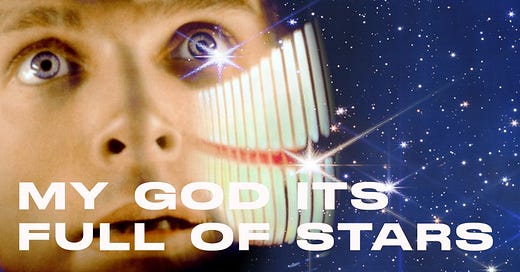At this point you might have seen the first image of the galaxy cluster SMACS 0723 released by the James Webb space telescope today. This image already blew my mind, especially when you compare it to the image shot by the Hubble telescope back in 2017. (UPDATE: Here’s a cool online toy to compare all released JWST-images to Hubble-versions.)
Whats amazing here isn't just that we look 5-13 billion years into the past and at hundreds of galaxies in this image, but the gravitational distortions, the swooshes and bulbs of light in what looks like some subtle photoshop effect is actually effects of gravitation from the mass of galaxies and dark matter, the phenomenon is called gravitational lense. Christopher Nolans Interstellar got some praise for being the first movie to realisticly show the gravitational bending of light and these images released by the James Webb telescope show you how close this movie was to the actual effects.
How much of a leap this new technology in space is for astronomy becomes clear when you look at those images in the high rez-versions available on the NASA-website (highly recommended) or look at this comparison video with some neat zooms to see the same fields of view layered over other shots from former space telescope tech. This is mindblowing af.


Here's the online toy shown in the video above with which you can compare all yet released James Webb-images to former available images. Do yourself a favor and hit this link, it’s so worth it. (The tool is a bit clumsy: You can choose the background in the top right corner and then have to switch back to the crossfader again with the same button. Go figure it out, it’s worth it.)
Then go and read this pretty good explainer by an astronomer on reddit to realize how much of a leap this is for astronomy:
A galaxy field called SMACS 0723, located 4.6 billion light years away. What's more, because of the orientation of the foreground galaxies we get to see some really zany gravitational lensing of light from galaxies much further away in this field- about 13 billion years, to be precise! So these are all very young galaxies, all formed just a few hundred thousand years after the Big Bang.
The thing to realize is even with these very first images, because JWST is able to see in detail no telescope has had before there's a ton of low hanging fruit. In the case of this image, one of the big outstanding questions is a feature called the UV luminosity function, which tells you the star formation rate in those early galaxies. If you literally just count up the number of galaxies you see in those first JWST images, you'll already know more about the star formation rate in the early universe than we do now! Further, when you study the gravitational lensing pattern, you can learn about those foreground galaxies- things like their mass, and how the dark matter is distributed around them.
Here’s another explainer by the same guy on Reddit about the new batch of images and here's all of the new JWT-Images: https://www.nasa.gov/webbfirstimages
You really should go and see the following image in high rez, the level of detail is incredible and I absolutely get that astronomers worldwide are completely stunned and very emotional about these images.
Behind the curtain of dust and gas in these “Cosmic Cliffs” are previously hidden baby stars, now uncovered by Webb. We know — this is a show-stopper. Just take a second to admire the Carina Nebula in all its glory.
The “Cosmic Cliffs” build on the legacy of Hubble’s imagery of the Carina Nebula, seen here. Webb’s new view gives us a rare peek into stars in their earliest, rapid stages of formation. For an individual star, this period only lasts about 50,000 to 100,000 years.
Two cameras are better than one, as seen in this combined view from Webb’s NIRCam & MIRI! In the near-infrared, we see hundreds of stars and background galaxies. Meanwhile, the mid-infrared shows us dusty planet-forming disks (in red and pink) around young stars.
Galactic high five! In Webb’s image of Stephan’s Quintet, we see 5 galaxies, 4 of which interact. (The left galaxy is in the foreground!) Webb will revolutionize our knowledge of star formation & gas interactions in these galaxies.
Galaxies collide in Stephan’s Quintet, pulling and stretching each other in a gravitational dance. In the mid-infrared view here, see how Webb pierces through dust, giving new insight into how interactions like these may have driven galaxy evolution in the early universe.
Webb's mosaic is its largest image to date, covering an area of the sky 1/5 of the Moon’s diameter (as seen from Earth). It contains more than 150 million pixels and is constructed from about 1,000 image files. Compare the new image to Hubble’s 2009 view, shown here!
Compare views of the Southern Ring nebula and its pair of stars by Webb’s NIRCam (L) & MIRI (R) instruments. The dimmer, dying star is expelling gas and dust that Webb sees through in unprecedented detail.











